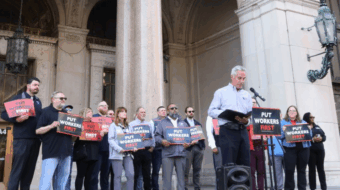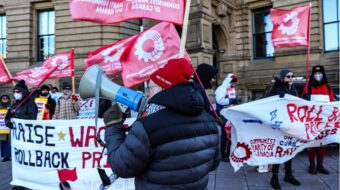People are angry in New York City – and they have a right to be angry. Every day massive cuts in local and state spending appear more and more imminent. At the state level, revenues are 10 percent below what is needed. At the local level, Mayor Michael Bloomberg says unless the city gets $2.7 billion from the state, cuts the size of which have not been seen for decades, will gut city services.
On the state level, the budget is $9.3 billion short, according to Governor George Pataki, or between $10 to $12 billion short, according to NY State Senate Majority Leader Joe Bruno. According to a document issued by the Working Families Party (WFP), the budget proposed by the Governor reduces health care spending by $2 billion and education spending by $1.45 billion. These cuts, according to labor, community, and neighborhood organizations, would wreak havoc on the lives of New Yorkers.
“The proposed cuts were close to $2 billion dollars. That would force hospitals to close, and it would force staffing to dwindle,” Chris Flemming, a spokesperson for Service Employees International Union (SEIU) Local 1199, told the World. 1199 SEIU is the largest union for workers in New York State’s health care system.
“Governor Pataki’s budget proposals would disrupt health care for hundreds of thousands of children now and thousands more in the future, when these children are forced to transfer out of the Medicaid program simply because they become six years old,” a statement issued by the Children’s Defense Fund said. “The Governor would additionally cut school aid by $1.24 billion, eliminating funding for 60,000 four year olds participating in Universal Pre-Kindergarten (UPK), and eliminating after school and jobs programs for over 100,000 young people throughout the state.”
The major problem with the budget, critics say, is that it cuts the programs of the people who need it most. “The most direct impact of Pataki’s $1.2 billion in proposed Medicaid cuts will be on [elderly] recipients,” says the WFP.
In New York City, the budget situation is even more alarming. Facing a shortfall of $3.8 billion, Bloomberg has put forward two different budgets, each based on the amount of money that the city may receive in aid from Albany. One, described as “painful,” calls for layoffs of some 4,500 city workers; the other called “the Doomsday plan” calls for over 10,000 layoffs.
The first plan can work, only if the legislature grants the city authority to levy a commuter tax on people living outside the city limits, which Bloomberg is asking for. The “Doomsday” plan comes into play if the city receives none of the $2.7 billion from the state for which the mayor has asked.
But even the best-case scenario is drastic. It would eliminate all summer school programs for all but students in danger of failing. It would lay off 1,813 school workers, 194 fire department workers and 109 homeless shelter cleaners. Parks and libraries would be affected. Lunches for seniors at city shelters would be eliminated. The list goes on.
Even the city’s zoos would be affected. “This is not a budgetary exercise,” said Steven E. Sanderson, president and chief executive officer of the Wildlife Conservation Society. “This is the lives of 211 people, the displacement of thousands of animals, and the dismantling of the world’s largest and most distinguished network of urban wildlife.”
The doomsday budget, which includes another billion dollars in cuts, is aptly named.
Under it another 1,426 school workers would be laid off. The police force would be cut to its lowest level in over a decade. Subway and bus fare discounts for elderly and disabled people would be abolished.
The city’s streets would become filthy, possibly returning to the notorious situation of the budget crisis of the 1970s, as 1,142 sanitation workers are laid off. Out of 200 hundred firehouses, 40 would be closed.
After school programs would be eliminated. Every public pool would be closed, and a number of recreation centers would be shuttered as well. Every childhood health center would be gone and education programs aimed at reducing teen smoking would be abolished.
At the time of writing, it has just been announced that the Mayor is looking to cut subway and bus subsidies by another $200 million – which would require another increase in fares on top of a recent hike of 33 percent.
Contrary to statements made by Pataki, many labor and people’s organizations argue that this crisis never had to happen in the first place.
The state budget is in crisis because of massive tax cuts put into effect by Pataki over his past terms. A report by the State Department of Finance and Taxation said that revenues would be almost $12 billion higher had it not been for these cuts. Given that the Governor is saying that the budget shortfall is just over $9 billion, it is indeed arguable that, even with the problems created by the national recession and Sept. 11, the current state budget crisis could have been avoided, were if not for the lowering of taxes over the past decade.
Barbara Bowen, president of the Professional Staff Congress, the union for professors at the City University of New York, said, at a recent rally to protest education cuts, that the state Republicans’ agenda was skewed towards giving tax cuts to the rich and raising taxes on working people. She pointed out the fact that the vast majority of tax cuts had benefited the rich and corporations, “while at the same time raising tuition at CUNY, raising the fare on the MTA – aren’t these taxes on regular people?”
Bloomberg and others have tried to blame working people and their unions, and to balance the budget on their backs. The most recent example was when Bloomberg publicly demanded that municipal unions save $600 million dollars through givebacks.
“Members of our union make an average of $40,000 a year,” says Henning. “You’re asking them to give out of their pockets somewhere between $2,000 and $2,500. First of all, $40,000 a year salary to live in New York City in the year 2003 is hardly exorbitant. The simple fact is, as Willie Sutton used to say, ‘You gotta go get the money from where it is,’ and it’s not $40,000 a year income earners. It’s from the $400,000 a year and up, and those folks benefit greatly from the kind of city New York is. I don’t see any reason why they wouldn’t be willing to pay their fair share.”
Instead of agreeing to place the burden of the economy on regular working people, the municipal unions offered to work with the city to save money through innovative measures. However, this was rejected by Bloomberg.
Just as at the state level, the city budget crisis was caused by a refusal of a Republican administration to use a fair tax system. While the amount of the city’s budget shortfall is $3.8 billion, it is documented that the tax cuts of the Giuliani administration, which went mainly to high income earners, are costing New York City $2.6 billion per year – more than half the shortfall!
In addition to cuts in services, Bloomberg’s budget is replete with taxes that affect working and poor people the most. For example, it raises property taxes 18.5 percent. Property taxes are amongst the most regressive, as they take a bigger portion of the income of lower income earners through tax or increases in rent than from those in higher brackets.
“You won’t hear many of the talking heads on television speak of the unfair, shortsighted and unwise economic policies that slashed city services, handed over large chunks of city revenues to big business and left NYC’s working families behind as the rich enjoyed an economic boom,” says Communication Workers of America (CWA) Local 1180.
At the same time that the budget
cuts are set to gouge New York, a broad movement for a people’s budget, the size of which has also not been seen in decades, if ever, has taken shape. This movement includes all the municipal unions, community organizations, an unprecedented new coalition called the “People’s Lobby for a Fair Budget,” (PLFB) as well as a wide array of others, at both the local and state levels.
The PFLB was formed by the New York City Central Labor Council, the Working Families Party, CWA Local 1180, the Association of Community Organizations for Reform Now (ACORN), and the Municipal Labor Council. Recently, an indoor rally was held at the office of the CLC to publicly kick the coalition off.
The coalition is formed around four main demands that argue the money to fix the budgets can be found by taking it from the right places. The demands are 1) a surcharge on income over $100,000 per year; 2) a reinstatement of a commuter tax for New York City, based on the idea that the residents of suburbs, who are more affluent on the whole than city residents, should pay for the municipal services they use; 3) the closing of corporate tax loopholes, as has been done in parts of New Jersey; and 4) the reinstatement of a tiny tax on all stocks sold on the New York Stock Exchange. According to WFP estimates, the first demand could raise $1.6 billion to $8 billion. Demand three, when done in New Jersey, was able to raise $1 billion.
Local 1199 SEIU has moved into the battle at the state level. On April 1, this union held the largest demonstration in the city of Albany’s history, against cuts to health care. The union demanded a small tax on the rich, and as of press time, there has been movement in the legislature towards such a step, due to the public pressure that the growing movement has placed on state lawmakers.
The American Federation of State, County and Municipal Employees (AFSCME) District Council 37, a main union of city employees, will hold a major demonstration at New York City Hall in protest of the proposed budget cuts on April 27 from 5:30 p.m. to 7:30 p.m. United for Peace and Justice, the leading peace coalition, has endorsed the event, in an effort to illustrate “the injustice of the fact that our cities are falling apart for lack of funds while the Bush administration can spend tens of billions of dollars on an unjust and unnecessary war.”
Statewide, thousands have moved into the struggle against the budget cuts, to demand a fair system. The Transit Workers Union Local 100 has worked with the Straphangers Campaign, an organization of public transit passengers, to fight booth closings and fare hikes. The Alliance for Quality Education (AQE), which unites parents, students, and educators, has been organizing and holding mass rallies. “We have to make sure that [the Republican lawmakers] can’t come home with a budget that makes these cuts. Rallies, public meetings, letter writing campaigns, all kinds of things,” said Christine Marinoni, a leader of the AQE.
The author can be reached at dmargolis@pww.org









